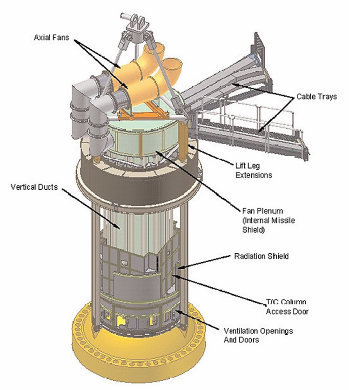Background
Reactor head disassembly and reassembly activities are major considerations when it comes to the refueling outage critical path schedule, personnel radiation exposure, critical containment resources, personnel safety and cost. The Westinghouse integrated head package (IHP) is an enhanced equipment design that offers a significant improvement in outage time. The IHP includes features specifically designed to reduce the efforts associated with disassembling and reassembling the reactor head in support of plant refueling.
Westinghouse has developed simplified head assembly (SHA) designs that cost-effectively back-fit the outage optimization features of the IHP into an operating plant. This can be done as a stand-alone project or as part of a reactor vessel head replacement. SHAs allow for permanent removal of the control rod drive mechanism (CRDM) or control element drive mechanism (CEDM) ductwork and separate missile shield, thereby eliminating significant time and dose associated with handling these items during the refueling outage. Westinghouse can provide SHA packages that allow the reactor head lift tripod to remain permanently assembled to the reactor head.
Additionally, the SHA package simplifies the CRDM/CEDM and rod position indication (RPI) cable arrangement, whereby the cables can be disconnected at a common connector panel that is located away from the high-dosage rate area at the top of the CRDM/CEDM housings.
Description
Specific designs are developed for individual plants. These designs can range from an optimization of the plant’s existing ductwork to a complete integrated package redesign incorporating radiation shielding, the CRDM/ CEDM cooling system with fans, a cable management system and a permanently installed missile shield.
The SHA incorporates a radiation shield and cooling shroud assembly that is attached to the reactor vessel closure head at the CRDM/ CEDM elevation. The CRDM/CEDM cooling system can include fans installed onto the head assembly; locating the fans away from the closure head eliminates the need for ductwork removal/installation on the closure head. An integral missile shield, which attaches to the existing plant lifting rig, eliminates the need for a separate missile shield and the associated handling and storage. Improvement of the CRDM/CEDM and RPI cable management can be realized by incorporating a bridge or bridges that contain connector panels. Depending on the containment layout, these bridges can be mounted either on the seismic support platform or on the containment floor. The preparation for head lift is reduced to disconnecting the cables at the common connector panels, swinging the cable bridge clear (either manually or electrically), removing the seismic tie rods and connecting the polar crane to the head lift rig. After de-tensioning and removing the studs, the head is ready to be lifted.
Westinghouse has provided SHA upgrade packages to the original Westinghouse fleet of plants and has also designed and implemented similar features for the original Combustion Engineering fleet of plants.

Reactor vessel head with simplified head assembly upgrade
Benefits
The SHA package can provide a number of benefits:
- Significant reduction in critical path time of three to four days
- Reduction in personnel radiation exposure associated with reactor head disassembly and reassembly activities (five to 10 rem at most plants)
- Reduction in critical containment building resources, thereby freeing resources to support other activities
- Reduction in polar crane usage and containment laydown space
- Reduction in risks to plant personnel safety programs associated with the disassembly and reassembly of CRDM/CEDM cooling system duct work, missile shield and other activities
Deliverables
Westinghouse provides the following as part of the SHA package implementation:
- A complete design package including assembly and arrangement drawings, as well as a design report
- New SHA components
- CRDM/CEDM, RPI and thermocouple cabling, if required, consistent with the modified cable configuration
- Quality assurance documentation associated with the hardware
- Licensing assistance
- Plant change package input
- Installation services
The lead time required for the SHA is approximately 24 months. Installation is completed during the refueling outage, which can be done without impacting the outage critical path schedule.


